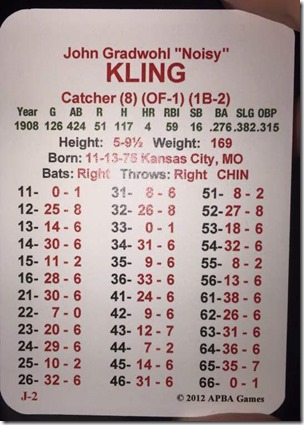Ken Schulz sent this 1908 Johnny Kling card in a while ago. I had it tagged as a Weird card but it took me a few seconds to figure out what was so strange about it. Can you?
According to SABR’s bio of Kling, he was called “Noisy” because of his on the field chattering. It’s worth noting that Kling has three 31s (and only one 13) on this card (that’s not the weird thing).
If you haven’t figured it out yet, Kling has a 22-0 in the second column. He doesn’t deserve four zeroes so he should get a 22-7 with either a 1 or a 2 in the second column.





Oops!
I almost missed it because I was looking for something more subtle. But when I saw it I couldn’t unsee it.
At first I thought it may have been the 23-20 as I thought APBA was done doing the two “error” result cards, but once I gave up and read it was suddenly so obvious.
Does that mean if you roll a 66-0 and a second column 22-0 you get a third roll?
Thanks for posting, Tom. I played the 1908 Cubs in the Praireland Tournament and I never even noticed this!
I looked up Johnny Kling’s 1908 season and he had 5 triples and 4 home runs. On his card, he has 5 2s and 3 1s in the second column (ignoring the 22-0). From that, one can deduce that the 22-0 should be a 22-1. If you make the 22-0 a 22-2, then he has twice as many triples as home runs which would not be consistent with his actual stats. Making the 22-0 a 22-1 fits neatly with his actual stats.
Probably should be a second column-1; Johnny Kling was probably the real backbone of these great Cubs ballclubs, he took a year off and the Cubs missed out on a pennant, he came back they were all good again. He knew how to talk to the umpire and was great at framing pitches, the umpires as well liked him, due to the fact Kling showed them respect.
If you play the card as printed, supposedly if Kling rolled an 11, a 33 or a 66, and then rolled a 22, another roll would be awarded for the 0 in the second column. If the league rules state to play the card as printed, it could lead to some interesting at bats.